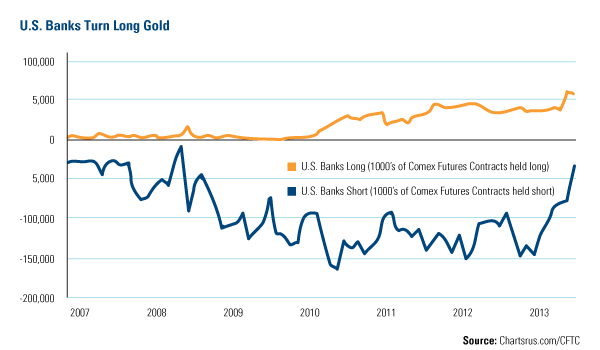Gold Market Radar (June 24, 2013)
For the week, spot gold closed at $1,296.40, down $94.34 per ounce, or 6.78 percent. Gold stocks, as measured by the NYSE Arca Gold Miners Index, lost 11.72 percent. The U.S. Trade-Weighted Dollar Index rose 2.16 percent for the week.
Strengths
- The chart above refers to a recent study of open interest figures in Comex that shows U.S. banks have turned their record short gold position into a record long position, according to Dutch journalist and founder of the Commodity Discovery Fund Willem Middelkoop. To note is that U.S. banks held their short positions since at least 2007 and have turned long at a time when technical indicators all show oversold levels and point to an imminent correction. According to Middelkoop, gold has gained at least 80 percent from the bottom of each correction within three years.
- Despite the Indian government’s efforts to curtail the sale of bullion in the country, the fascination of Indians for the yellow metal remains unrivaled. Public sector banks across the country are reporting sales of more than one tonne of gold in the last fiscal year, while post offices continue to see a boom in sale of gold coins. At the Bank of India, officials report gold turnover soared to $593 million from the $472 million in the precious fiscal year. Similarly, Scotiabank analysts report that overnight on Thursday, premiums for gold physical delivery in Shanghai jumped to a staggering $34.82 per ounce. The likely conclusion is that China is buying the dip, and it is buying it large.
- Agnico Eagle Mines, one of Canada’s major gold producers, in considering participation in joint ventures, as well as purchases of operating mines. The company may even look outside of North America for expansion, defying the acquisition criteria it has followed for decades according to a Bloomberg report. Sean Boyd, the company’s CEO commented the company may reach beyond its usual acquisition criteria as long as it doesn’t increase financial risk for the company. It is our opinion that successful leadership is cognizant of the recent changes in capital markets and the new role senior producers and royalty companies play in the financing and advancing of new projects.
Weaknesses
- Societe General reports 16 percent of world gold production is already loss-making and a staggering 44 percent of world production is estimated to be loss-making at a gold price of $1,150, based on its 2014 annual average forecast. SocGen has arguments stating why a marginal cost shouldn’t be deemed appropriate to set price floors, especially in the case of gold; however, the fact that some producers have already shelved multiple exploration and development projects is testament to the hardships in the industry. In our view, this cost analysis suggests that there is little downside risk left for the gold price.
- Harmony Gold is assessing the carrying value of its assets to determine impairments to its assets resulting from a number of factors including: estimates of the future gold price and exchange rates, and operating and capital cost estimates. The company has warned it appears likely that there will be a write-down of a portion of the carrying value of Hidden Valley in Papua New Guinea, due to its recent poor performance and the reduction in the U.S. dollar gold and silver prices. Despite this expected non-cash charge, we remain confident the company is in a position to increase production and improve grade recoveries, at a time they benefit from the devaluation of the South African Rand.
- The first scheduled shipment from the massive Oyu Tolgoi project in Mongolia has been halted by order of the central government. The shipment, originally supposed to be made on June 21, was ordered to be halted by the government without providing any details. The speculation among analysts is that the shipment issue would be resolved rapidly as the government is in dire need of foreign exchange. Regardless, our experience has shown that governments elsewhere have in the past held gold shipments as ransom for bargaining power in negotiations for higher taxes and royalties.
Opportunities
- TD Securities in its Precious Metals Outlook commentary provided an analysis of large cap gold equities and their current price-to-book value. As the chart above highlights, large caps are currently trading just below 1x book value, a level that has marked previous gold equity bottoms. Gold equities bottomed at about 1x book value during the global financial crisis and during the late 1990s gold bear market.
- The Chicago Mercantile Exchange has raised margin requirements on gold for the second time since April this year. The minimum cash deposit for gold futures will rise 25 percent to $8,800 per 100-ounce contract at the close of trading this Friday. Higher margin requirements have been traditionally deemed disruptive to the rise of gold prices, however, at this juncture we believe the increase in margin will give continuity to the transition of gold ownership from speculators to what we deem strong hands.
- Barclays reports that Zijin Mining Group out of China is interested in purchasing Barrick Gold’s Australian mines that were previously announced for sale in January 2013. The Chinese gold producer is citing the recent drop in gold price as an opportunity to look at assets for sale overseas. Although Zijin has stated that it is interested in the mines, the company is still weighing its options and no formal offer has been made as of yet. This is a positive data point for Barrick which had previously announced that it was interested in selling certain non-core assets. The report also highlights the opportunity for gold producers to make meaningful growth acquisitions at this time.
Threats
- The Federal Reserve on Wednesday trimmed its inflation outlook, suggesting it saw little threat to prices from its ongoing quantitative easing program. The Fed projected inflation between 0.8-1.2 percent for 2013, instead of 1.3-1.7 projected in March. However, and despite the markets reaction to gold, the Fed predicted inflation will rise considerably in 2014 and 2015. Despite our opinion on the Fed’s poor inflation forecasting track record, we believe the Fed’s warning for a noteworthy rise in inflation for 2014 should not be taken lightly, and investors should continue to allocate funds to assets that offer inflation protection such as gold.
- Last week, the Santa Cruz province in Argentina passed a bill levying a 1 percent annual tax on mine resources in the province. The tax could cost mining companies in the province $100 million in new taxes next year, and would amount to about 8 percent of the total resources of a mine with a 15-year life, considering that it must be paid annually, according to local mining executive. Similarly, Brazil is considering doubling mining royalties from 2 percent to 4 percent to all mining companies, including precious metals producers. It has always been our position that such levies are a frontal attack towards an industry that assumes large risks while providing much needed capital and development to the most remote locations of the world.
- China's seven day repo rate rose to a record high of 10.77 percent in Shanghai in what appears to predict a coming liquidity squeeze in China. Despite the fact that the central bank’s can practically provide unlimited liquidity it seems to be in no mood to support banks' constant demand for liquidity. The short term squeeze has the potential to affect the yellow metal’s prices in the short run as investors may use gold as a source of liquidity amid the tightening. However, a sustained increase in rates in the long run would have funds flowing back to hard assets such as gold, in a similar fashion to the events of the 2008 crisis in the U.S.















